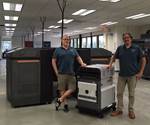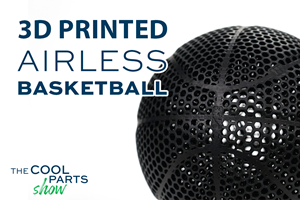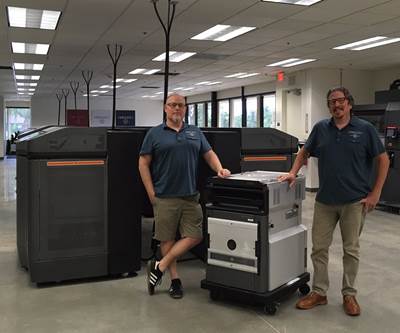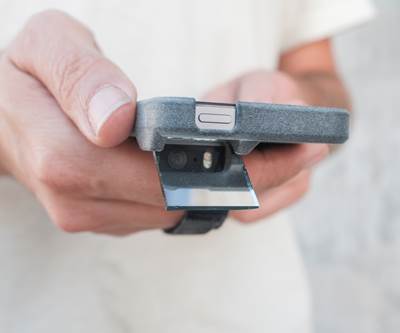Video: 3D Printing Is a Complement and Competitor to Injection Molding
Ken Burns of Forecast 3D, an early adopter of HP Multi Jet Fusion, sees 3D printing as both a complement and a competitor to injection molding. He shares why in this interview.
Is 3D printing a complement or a competitor to injection molding? For contract manufacturer Forecast 3D, it is both. As an early adopter of Multi Jet Fusion technology from HP, Forecast 3D believes it has found a 3D printing technology capable of competing with injection molding in the right applications and quantities. But, that doesn’t mean that 3D printing is always the best or only answer for production.
Ken Burns, technical sales director for Forecast 3D, shares his perspective with this interview, filmed during NPE2018. Watch below or read on for the transcript.
Transcript
Stephanie Hendrixson, Additive Manufacturing
I'm Stephanie Hendrixson with Additive Manufacturing. I'm here with Ken Burns, technical sales director at Forecast 3D. Ken, tell us a little bit about your company.
Ken Burns, Forecast 3D
Sure. So, Forecast 3D's been around since 1994. We've historically focused a lot in the prototyping markets, and some short-run production with some of our traditional services like cast urethane. Today we really define ourselves as a prototyping and a production house focused on the 3D printing opportunities out there.
Stephanie Hendrixson
And so one of the 3D printing technologies that you use is HP's Multi Jet Fusion. Why did Forecast choose to invest in this technology?
Ken Burns
For the first time, out of any 3D printing technology, we believe the HP technology could actually handle large volumes. The material properties, being more isotropic, have the ability to compete with injection molding materials out there, and the throughput of the systems can actually produce at volumes that allow you to go beyond the prototyping level.
Stephanie Hendrixson
You mentioned production as your focus for this technology. What kinds of quantities are we talking?
Ken Burns
We see most of our customers today are in the low thousands for production applications, although we do have a handful of customers that are doing tens of thousands of parts this year, and we'll have probably one or two customers that will produce over a million parts this year.
One of the applications that we've found is a really good fit are some of the industrial applications—think internal components on equipment. A second application that we've had a lot of success in is mass customization. That's what 3D printing's great for, and the throughput of the HP technology has allowed us to do that. So there's one customer specifically, Wiivv, they make custom insoles for orthotics and they also have a new product, a sandal, that has a custom orthotic on it. And then the other one is kind of in that low quantity point—so, hey, I'm going to make a thousand of these. I can go straight into production. I don't need to do anything else. Let's just produce.
Stephanie Hendrixson
Given all that you've learned about this system and the ways that you're using it, do you think that 3D printing is a complement or a competitor to injection molding?
Ken Burns
I actually would say it's both. Yes, it's going to take some opportunities away from injection molding, but at the end of the day, it's probably going to create a better market overall for whoever the end-use customer is. I honestly believe that it just means growing the market in both those opportunities. It's better solidifying where injection molding has its place, and where 3D printing has its place for the larger volumes.
Stephanie Hendrixson
Ken, thank you for joining me and talking a little more about Forecast 3D, and what you've learned about 3D printing for production as well as prototyping.
Ken Burns
You bet. Always a pleasure.
Related Content
Airless Basketball Shows Promise of 3D Printed Lattices: The Cool Parts Show Bonus
Successfully matching the performance of a standard basketball demonstrates the control possible over the mechanical properties of digital materials.
Read MoreHow to Build 10,000+ Shot Molds in Hours
Rapid tooling isn’t so rapid when it takes days to 3D print a metal mold, and then you still must machine it to reach the necessary tolerances. With Nexa3D’s polymer process you can print a mold in hours that is prototype or production ready and can last for more than 10,000 shots.
Read More3D Printing with Plastic Pellets – What You Need to Know
A few 3D printers today are capable of working directly with resin pellets for feedstock. That brings extreme flexibility in material options, but also requires greater knowledge of how to best process any given resin. Here’s how FGF machine maker JuggerBot 3D addresses both the printing technology and the process know-how.
Read MoreWhat Does Additive Manufacturing Readiness Look Like?
The promise of distributed manufacturing is alluring, but to get there AM first needs to master scale production. GKN Additive’s Michigan facility illustrates what the journey might look like.
Read MoreRead Next
How Forecast 3D Is Taking 3D Printing into Mass Production
Forecast 3D got its start building silicone molds from 3D-printed master patterns. Now, through the use of Multi Jet Fusion, the company sees a future in manufacturing large quantities of 3D-printed parts.
Read MoreNiche Manufacturer Discovers How Additive and Amazon Go Together
The economics of 3D printing allow for cost-effective production of niche products, and Amazon Prime offers a way to distribute them. The Periscope Case is one company’s first venture into an all-new model aimed at bringing products to market that would never have been profitable before.
Read MoreHybrid Additive Manufacturing Machine Tools Continue to Make Gains (Includes Video)
The hybrid machine tool is an idea that continues to advance. Two important developments of recent years expand the possibilities for this platform.
Read More
.jpg;width=70;height=70;mode=crop)




















